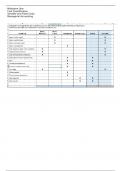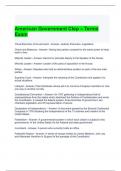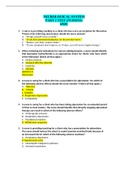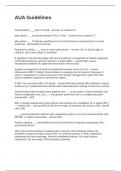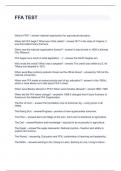Maura van de Kempe
Table of content
1.Export from a European and a global perspective ............................................................................... 4
1.1Export in the context of developments in the world economy ....................................................... 4
1.2 A more detailed definition of exporting and the Dutch situation in respect of export.................. 4
1.3 Trade policies and the European Union......................................................................................... 4
1.4 International cooperation and regional formation of blocs .......................................................... 5
1.5 The European Union Export Policy explained ................................................................................ 6
1.6 Regionalization and globalization ................................................................................................. 6
2.Export, a structural approach ............................................................................................................... 7
2.1 The Perlmutter theory and the process of internationalization .................................................... 7
2.2 A structural approach to export .................................................................................................... 9
2.3 The internal analysis ...................................................................................................................... 9
2.4 The export policy plan as a basis for a structural approach ........................................................ 10
3.Researching and selecting foreign markets ....................................................................................... 11
3.1 Growth strategies and international marketing/global marketing. ........................................... 11
3.3 Defining target groups and positioning....................................................................................... 11
3.4 Product/market combinations (PMCs) and Product/market/technology combinations (PMTs) 12
3.5 Segmentation and country selection ........................................................................................... 12
3.6 Country selection model .............................................................................................................. 12
3.7 Countries suitable for segmentation ........................................................................................... 12
3.8 Data collection ............................................................................................................................. 12
3.9 The internet and export information ........................................................................................... 12
4.Export planning .................................................................................................................................. 13
4.1 Planning ....................................................................................................................................... 13
4.2 Company policy ........................................................................................................................... 13
4.3 Strategy development ................................................................................................................. 13
4.4 Strategy test 1: the Company strategy ........................................................................................ 13
4.5 The export policy plan ................................................................................................................. 14
4.6 The export marketing mix ........................................................................................................... 14
4.7 The export marketing strategy .................................................................................................... 14
4.8 Strategy test 2: the export marketing strategy ........................................................................... 15
1
Export Management, a European perspective Maura van de Kempe
, 4.9 The export marketing plan .......................................................................................................... 15
4.10 Target group value and the export policy plan ......................................................................... 15
4.11 Implementation and internal marketing ................................................................................... 15
4.12 Strategy test 3: Target group value ........................................................................................... 15
4.13 Conclusion and forecast ............................................................................................................ 15
5.Choosing an entry strategy ................................................................................................................ 16
5.1 Methods of exporting and entry strategies ................................................................................. 16
5.2 Indirect export ............................................................................................................................. 16
5.3 Producing abroad ........................................................................................................................ 18
5.5 Competition in foreign markets ................................................................................................... 18
5.6 Internal influences on the choice of distribution channel............................................................ 18
5.7 Mergers and acquisitions ............................................................................................................ 19
5.8 Strategic alliances........................................................................................................................ 19
6.Financial policy in Exports .................................................................................................................. 20
6.1 Organization of financial policy ................................................................................................... 20
6.2 Various financial characteristics of an export business ............................................................... 20
6.3 Covering against currency risk..................................................................................................... 20
6.4 Policy relating to debtors............................................................................................................. 21
6.5 Export credit insurance ................................................................................................................ 22
6.6 International payments ............................................................................................................... 22
6.7 Financial documents .................................................................................................................... 23
6.8 Bank Guarantees ......................................................................................................................... 23
7.Exports, logistics and customs policy ................................................................................................. 25
7.1 Logistics at the strategic level ..................................................................................................... 25
7.2 Customs policy ............................................................................................................................. 25
7.3 Logistics at the tactical level........................................................................................................ 25
7.4 Customs at the tactical level........................................................................................................ 26
7.5 Logistics at the operational level ................................................................................................. 26
7.6 Customs at the operational level ................................................................................................. 27
8.Cultural pitfalls in international business ........................................................................................... 28
8.1 Dealing with other cultures ......................................................................................................... 28
8.2 The importance of the cultural and ethnical dimensions ............................................................ 28
8.3 Cultural hardware system ........................................................................................................... 28
8.4 Cultural orgware systems in marketing practice ......................................................................... 28
2
Export Management, a European perspective Maura van de Kempe
, 8.5 Culture at the level of software ................................................................................................... 29
8.6 Practical recommendations ......................................................................................................... 29
9. Important legal aspect of exporting .................................................................................................. 30
9.1 Agreement ................................................................................................................................... 30
9.2 General conditions ....................................................................................................................... 31
9.3 Intellectual property rights .......................................................................................................... 32
9.4 Settlement of disputes ................................................................................................................. 32
9.5 Intermediaries ............................................................................................................................. 32
9.6 Consumer protection ................................................................................................................... 33
10. The export policy plan ..................................................................................................................... 34
10.1 The export policy plan: for whom? ............................................................................................ 34
10.2 Defining the market................................................................................................................... 34
10.3 The export policy plan: a practical framework .......................................................................... 34
10.4 The export policy audit .............................................................................................................. 34
10.5 Elaboration of the export policy audit ....................................................................................... 34
3
Export Management, a European perspective Maura van de Kempe
,1.Export from a European and a global perspective
The world economy has suffered a serious recession and the foundations of the international
economic order have undergone important changes as a result of internationalizing. For both large
and small countries international trade is a vital importance and a decisive factor in the pursuit of
prosperity.
1.1Export in the context of developments in the world economy
The world economic recession has a direct effect on export business. It seems justifiable to ask
whether American and Europe can still be called ‘export-absorbing’ countries. The EU is the biggest
exporter in the world and the second biggest importer, after the USA. The EU is responsible for one
fifth of world trade. The Netherlands export more than any other European country. More than 70%
of Dutch goods and services destined for export are exported within the EU, so a stable European
market is essential for Dutch export.
EU is the biggest exporter in the world. Its two major trading partners are the USA and Japan.
Germany remains the Netherlands’ favorite trading partner. Traditionally, Belgium comes in second
and the UK and France share third place. In 2005 the port of Rotterdam totaled a record in
transshipments of 369 million tones.
1.2 A more detailed definition of exporting and the Dutch situation in respect of export.
Exportation; the export of products manufactured in the country
Re-importation; importation with added value of products that had first been exported
Re-exportation; exportation of imports with little added value (flowers)
Transit; shipping on of goods that physically arrive in the Netherlands and are traded freely but
reaming the property of a foreign resident (container transport, for instance) there is therefore, no
transfer of ownership to a Dutch resident.
Import and export in the Netherlands, including re-exportation, but excluding transit, have each been
at over 50% of the GDP for years. Re-exportation is especially important for the Netherlands, they
are even at the same level as Hong Kong and Singapore. The Netherlands is known as a distribution
country rather than an export country.
1.3 Trade policies and the European Union
Free trade policy: according to free trade policy, international trade is carried out entirely according
to the laws of supply and demand. This policy has a number of advantages, such as efficient
competition and thus technological innovation, more international stabilization of prices.
The most important treaty in which the policy of free trade was laid down was the General
Agreement on Tariffs and Trade: The GATT. The GATT’s objective was the abolition of mutual trade
barriers between the signatories. This has been signed by 123 countries. The Status of the World
Trade Organization (WTO) is comparable with that of the World Bank of the International Monetary
Fund (IMF). One of the tasks of the WTO is to check adherence to the GATT treaty, to provide new
stimuli of negotiations which have not yet been completed (in the area of financial service, for
instance) and to initiate various trade-related policies (regarding investments, competition and
labour standards.)
The settlement of differences is an important task the WHO has to perform.
4
Export Management, a European perspective Maura van de Kempe
, Trade policies and concomitant measures by a country or a group of countries to protect their own
industries are called protection or protectionism. Price and quantities are controlled.
A company that operates internationally may be confronted with the following traditional
protectionist measures: Import duties (also known as tariffs), export duties, import and tariff quotas,
trade agreements, non-tariff linked barriers, government trade and management trade.
1.4 International cooperation and regional formation of blocs
After 1950 efforts to achieve free trade led on the one hand to international cooperation and on the
other to the formation of regional blocs. Countries have various ways of cooperating with each other.
The simplest form of cooperation is the removal of tariffs and quotas to a greater of lesser extent.
The resulting types of trade bloc include the preferential area, the free trade area, the tariff union
and the customs union. Economic unions are far-reaching forms of cooperation.
In a preferential area a number of countries which are part of the area allow one another
preferential tariffs; in a free trade area participating countries mutually abolish import duties, but
they retain their individual tariffs in respect of other countries. This results in a certificates of origin’
condition.
Examples of free trade areas can be found all over the world. Examples are European Free Trade
Agreement (EFTA) the Central European Free Trade Agreement (CEFTA). North American Free Trade
Association (NAFTA), a cooperation between Canada, Mexico and the USA. Caribbean Basin Initiative
(CBI). South America has the Mercosur, whose include Argentina, Brazil, Paraguay, Uruguay, Chile
and the Andes countries. Asia has the Asian Pacific Economic cooperation (APEC). Africa has the
Southern African Development Community (SADC) and the Economic Community of West African
States (Ecowas).
5
Export Management, a European perspective Maura van de Kempe



